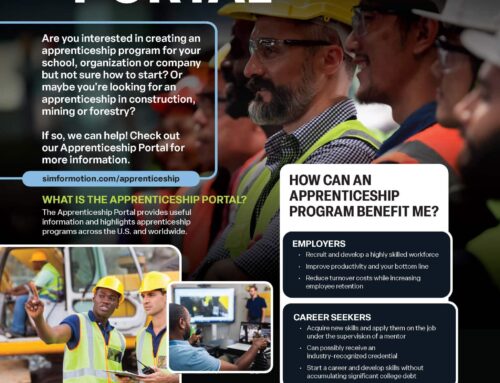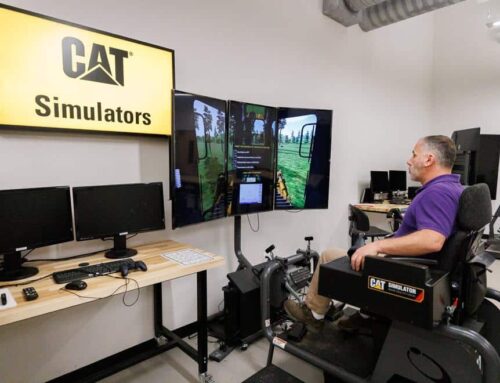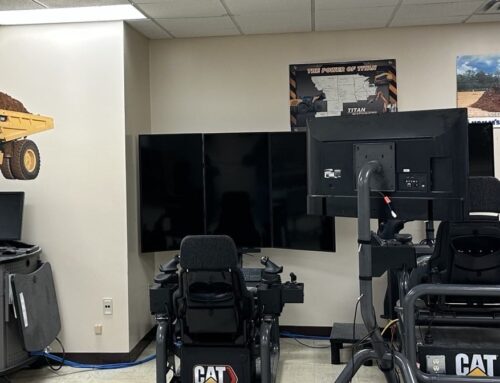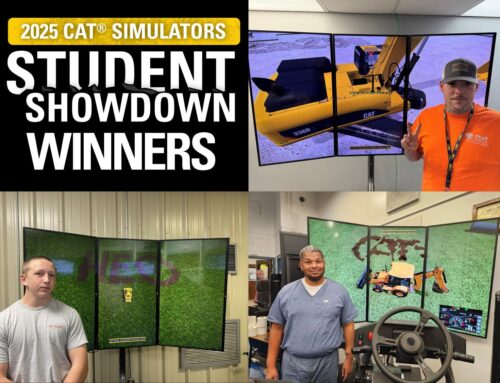Danny Turner is the Training and Development Coordinator at Aecon Mining in Alberta, Canada. He has worked in construction for 40 years, operating everything from the small dozers and excavators to the large hydraulic shovels found at massive mining operations. During the last 5 years in his role as Training and Development Coordinator, Turner developed a training and evaluation program used in its everyday work place to make its workforce safer and more productive. Cat® Simulators has played a very large part in the process.
The Need for Training
“After simulator training, the operators did a great job saving wear-and-tear on the equipment.”

Aecon began using simulators in its program 4 years ago. “At that time we were hiring a lot of new haul truck drivers and needed a way to prove they were proficient. We were hiring experienced workers and putting them to work only to find out they were not qualified,” says Turner. Aecon needed a way to prove that operators were competent when onboarding. Approximately 350 operators go through training each year at the company. Both new operators and current operators moving up to different models of equipment (i.e. a truck to a dozer). With four Instructors, it’s a big job to get all operators through the program. Aecon chose to use simulators because they offered a controlled environment to train and evaluate workers. They currently use the Cat Hydraulic Excavator, Mining Truck and Large Track Type Tractor Simulator Systems because that’s what most of its workforce are now operating. Turner says, “Before the simulators, we put the operator on the equipment through various exercises to see if they fit what we require for a particular job with their skill set (a finished or inexperienced operator) – this used to take up many man hours.” This allows for a variety of scenarios in a simulated environment, before having to go into the field. “We would much rather have a mishap on a simulator than on actual equipment, thereby preventing any potential accidents and ensuring the safety of our team,” Turner adds. Currently, new operators receive at least 10-12 hours of simulation training.

After simulation training, the operators go into the field on actual machines for up to 14 days; and back to more simulator training if their instructors deem it necessary. Every operator receives the amount of training needed to bring them up to the program standards. New operators are exposed to simulation training first. Working in the safe environment of the simulators allows new operators to train without anxiety. For example, they are taught how to complete a pre-operation inspection using the simulator’s Walkaround module. Controls Familiarization teaches them a good understanding of how to make the fine movements of the machine controls. Open Training helps overall, to develop the motor skills needed to operate the equipment. “The addition of the motion system on the simulators brings an even more lifelike feeling to the experience,” says Turner. Cat Simulators developed the add-on motion system to increase training value. Programmers worked with motion specialists and a Caterpillar senior engineer specialist to provide very specific information between the simulator and motion system. In turn the simulated machine’s physics respond/react realistically to the environment, maneuvers and terrain interaction. When on the simulator, the user experiences a degree of movement that translates all the way up to the user’s head.
Turner says that instructors like using the simulators for training because improvements translate to the job site. Instructors can explain what to do from the classroom, before operators get on the job site. Instructors can train on important aspects like conducting a machine inspection; safe and correct operation procedures using the same controls as in actual machines; and they can test operators to show them what mistakes they make and help them improve their techniques. The simulator sessions can be recorded and reported to track operator progress through SimU Campus™. The software features reports that can be generated for each user based on training exercises and benchmarks set up by the instructor. Aecon uses the software to set up classes; set up each user and record the results of simulation sessions. The instructors screen all operators using the simulators. Turner shares what the instructors focus on during the exercises and right after completion.
- The operator’s skill level.
- Their understanding of the equipment.
- How they handle the simulator.
- Their attitude towards the equipment.
- Their understanding of safe equipment operation.
- Their overall attitude.
- Their overall experience (talk with them while on the simulator).
Experienced operators are also screened using the simulators. Simulator training can help increase their production and reduce wear-and-tear on the machines.
- Testing on the Walkaround module covering machine inspections.
- Testing to reveal bad habits.
- Testing on machine applications that reveal their production levels and the amount of wear-and-tear they create for the machines and determining what, if anything, needs to be corrected.
Turner remembers one particular very experienced haul truck driver that would not use the manual retarder. He failed the exercise three times (overheating his brakes). Instructors explained the difference between the foot brake and the manual retarder and how it cools the brakes. Now he is out on-site explaining the difference to other drivers.
“Some of our experienced excavator operators could not pass the simulator benchmarks at first, until we showed them what they were doing wrong (overloading the bucket, not setting up right, and overloading trucks). After simulator training, the operators did a great job saving wear-and-tear on the equipment. They took what they learned back into the field.”
Proof of Improvement
According to Turner, the most effective part of training with simulators is teaching Aecon’s employees the proper way to operate a particular type of equipment. Plus, the simulators are saving training time, Turner shares. “Every hour on the simulator reduces the machine training a lot.” Simulators can give our operators the base understanding of the equipment. When we’re unsure of an operator’s skill level, we can catch it on the simulators. Using simulators, we can train operators to perform applications the right way instead of them learning other operators’ bad habits. Most often, Aecon’s operators are working for clients at client sites and under client rules. Aecon cannot afford mistakes on-site. Turner says, “If operators are going to make a mistake we would rather it’s in the classroom than on the mine site.” He believes that operator mishaps have decreased since training began on the simulators. “We are getting more safely orientated and more informed operators now by using the simulators.” Part of that has been a change of mindset among experienced operators that think simulation is just a big video game. Once they get on the simulator they see that it is very close to the real thing. Simulator training has become an important part of Aecon’s operator training program. In light of the current mining downturn, it’s critical to get the most out of production, always with safety in mind. That begins with the operators and how they handle the machines.






